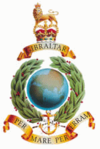- No. 46 (Royal Marine) Commando
-
No. 46 (Royal Marine) Commando 
Cap Badge of the Royal MarinesActive 1 August 1943–31 January 1946 Country United Kingdom Branch Royal Marines Type Commando Role Coastal raiding force
Assault InfantrySize One battalion Part of 4th Special Service Brigade Nickname Four Four Motto Per Mare Per Terram (By Sea By Land) (Latin) March Quick - A Life on the Ocean Wave
Slow - PreobrajenskyCommanders Notable
commandersLieutenant Colonel Campbell Richard Hardy Insignia Combined Operations Shoulder Patch 
No. 46 (Royal Marine) Commando was a battalion size formation in the British Commandos, formed in August 1943 during the Second World War. The Commando was assigned to the 4th Special Service Brigade and served North West Europe and took part in the Normandy Landings, operations around Ostend and Antwerp before being disbanded in January 1946.
Contents
Background
The British Commandos were formed in 1940, by the order of Winston Churchill the British Prime Minister. He called for specially trained troops that would "develop a reign of terror down the enemy coast".[1] At first they were a small force of volunteers who carried out small raids against enemy occupied territory, [2] but by 1943 there role had changed into lightly equipped assault Infantry which specialised in spearheading amphibious landings.[3]
The man selected as the overall commander of the force was Admiral Sir Roger Keyes himself a veteran of the landings at Galipoli and the Zeebrugge raid in the First World War.[4] Initially the Commandos were a British Army formation the first Royal Marine Commando was formed in 1942.[5] The Royal Marine Commandos like all British Commandos went through the six week intensive commando course at Achnacarry. The course in the Scottish Highlands concentrated on fitness, speed marches, weapons training, map reading, climbing, small boat operations and demolitions both by day and by night.[6]
No. 46 (Royal Marine) Commando was formed in August 1943, under the command of Lieutenant Colonel C R Hardy as part of the conversion of the Royal Marine Division into commandos. Following training it was allocated to the 1st Special Service Brigade. It took part in the Normandy landings 6 June 1944, serving on the Orne River bridgehead alongside 6th Airborne Division. It suffered heavy casualties in Normandy and at the end of September 1944 was returned to the United Kingdom to refit. Returning to mainland Europe in January 1945 it was the Antwerp guard force. The commando then participated in a number of assault river crossing during the advance into Germany. At the end of the war the commando took part in the occupation of Germany before being disbanded in February 1946.[7]
Legacy
No. 46 (Royal Marine) Commando together with all the army commandos were disbanded after the Second World War and the commando role was taken over by the Royal Marines.[8] However the present day Parachute Regiment, Special Air Service and Special Boat Service can all trace their origins to the Commandos.[9][10][11]
Battle honours
The following Battle honours were awarded to the British Commandos during the Second World War.[12]
- Adriatic
- Alethangyaw
- Aller
- Anzio
- Argenta Gap
- Burma 1943–45
- Crete
- Dieppe
- Dives Crossing
- Djebel Choucha
- Flushing
- Greece 1944–45
- Italy 1943–45
- Kangaw
- Landing at Porto San Venere
- Landing in Sicily
- Leese
- Litani
- Madagascar
- Middle East 1941, 1942, 1944
- Monte Ornito
- Myebon
- Normandy Landing
- North Africa 1941–43
- North-West Europe 1942, 1944–1945
- Norway 1941
- Pursuit to Messina
- Rhine
- St. Nazaire
- Salerno
- Sedjenane 1
- Sicily 1943
- Steamroller Farm
- Syria 1941
- Termoli
- Vaagso
- Valli di Comacchio
- Westkapelle
References
- Notes
- Bibliography
- van der Bijl, Nick (2006). No. 10 Inter-Allied Commando 1942-45. Osprey Publishing. ISBN 1841769991.
- Chappell, Mike (1996). Army Commandos 1940-45. Osprey Publishing. ISBN 185532579925799.
- Fowler, Will (2009). Royal Marine Commando 1950-82: From Korea to the Falklands. Osprey Publishing. ISBN 1846033721.
- Haining, Peter (2006). The banzai hunters: the forgotten armada of little ships that defeated the Japanese, 1944-45. Robson. ISBN 1861059418.
- Moreman, Timothy Robert (2006). British Commandos 1940-46. Osprey Publishing. ISBN 184176986X.
- Neilands, Robin (2005). The Dieppe Raid. Indiana University Press. ISBN 0253347815.
- Shortt, James; McBride, Angus (1981). The Special Air Service. Osprey Publishing. ISBN 0850453968.
- Tomblin, Barbara (2004). With utmost spirit: Allied naval operations in the Mediterranean, 1942-1945. University Press of Kentucky. ISBN 0813123380.
 Commando sized units of the Royal Marines
Commando sized units of the Royal MarinesCurrent Units: 40 Commando · 42 Commando · 45 Commando · Fleet Protection Group Royal Marines · 30 Commando Information Exploitation Group · 1 Assault Group Royal MarinesFormer Units: 30 Commando · 41 Commando · 43 Commando · 44 Commando · 46 Commando · 47 Commando · 48 Commando
Categories:- Military units and formations established in 1943
- Military units and formations disestablished in 1946
- Military units and formations of the British Army in World War II
- British Commandos
- Royal Marine formations and units
Wikimedia Foundation. 2010.
